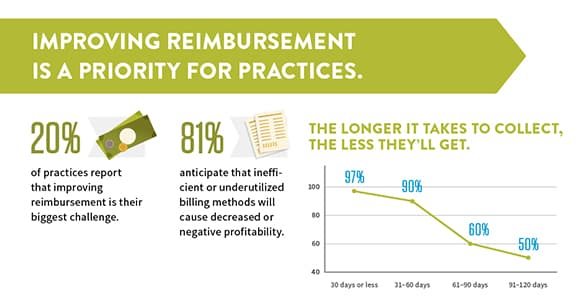Patient Collections Boot Camp: Part 1 (SlideShare)
Chances are, you want to improve your practice's patient collections process. You're not happy with the amount of patient A/R in the 90+ day range. You might still be sending out statements over a year old. This all needs to change, as the healthcare system continues to shift more financial responsibility over to patients.
We've brought in experienced healthcare business consultant Aimee Heckman to walk you through the process of shaping of your patient collections rate. Aimee's holistic approach involves a higher level of communication and education of front office staff and patients -- so that the patient pay conversation can happen early and often. Here's the recap of the Patient Collections Boot Camp: Part 1 -- Preparing Your Technology, Your Staff, and Your Financial Policy.
SlideShare
Q&A
Aimee covered key topics of interest to independent medical practice owners, managers and billers alike. She called Part 1 of the Patient Collections Boot Camp the essential "warm up" -- putting into place the foundational elements to build an effective patient collections process. Check out some of her answers to questions that came up during the boot camp:
1. What can you do to collect payment from a client if they have a high copay before the standard time when an insurance company will state the clients’ responsibility, and now they have racked up a bill of over $600?
Typically, the copay is a fixed amount and is cleared before the visit. For co-insurance, review your payer contracts and see if you are allowed to collect a deposit. Look to see if there is any language that strictly prohibits you from collecting an amount prior to adjudication. You can also keep a credit card on file for patients, and in your financial policy state that up to a certain amount their card will be charged once the balance is adjudicated for patient responsibility. The patients will receive and EOB, so they will know the amount they owe. You need the patient to agree on this, but as long as you set a maximum amount, patients will normally agree to this. You can then collect the additional amount in the following months.
2. Can you elaborate more on it being fraud to write off copays or deductibles? We bill for many physicians’ offices and we have had some clients do this in the past. We knew it wasn't best practice but not necessarily that it was fraud. More detail and documentation is appreciated.
For Medicare, under the False Claims Act it is considered fraud to routinely waive copays and deductible. The logic is you charge $100 for a service, insurance will pay 80%. If you routinely waive the 20%, then you should only charge the insurance company $80 because that is what you are accepting as the entire allowed amount. In many commercial payer contracts, it specifically states you cannot waive copays and deductibles. Breach of contract is technically different from fraud, but by Medicare definition that is considered fraud.
3. Is sending a patient statement by email considered HIPAA compliant?
Yes, if you have secure encrypted emails and patients’ permission. The best practice would be to send an email with a link for the patients to retrieve their patients’ statements. If you have a one-off where a patient is requesting a statement via email, it may be permissible to send a password protected document, and do not include the password in the email. Always check with your HIPAA Compliance officer prior to emailing patient information. A general practice is that offices are required to make an effort to protect that data.
4. Can you offer advice for direct pay practice model?
A lot more practices are transitioning to a direct pay model. Patients are effectively becoming self-pay because they don’t want to deal with insurances companies and high deductibles. You need to have a financial policy in place, credit card on file, clear expectation at time of service, payment plans and pricing for self-pay services.
5. I am in a hospitalist-type setting in Pediatric Critical Care services/inpatient hospital only. Any ideas for offices that don't see patients in an office/copay setting? I have some patients that owe large amounts and some small, but once their child is discharged, it is hard getting payment from either.?
Unfortunately, patient collections in an acute care/in-patient setting are even more difficult than office settings because you don’t have the ongoing relationship with the patient and their guardian, in the case of a pediatric setting. Complicating matters further, in a pediatric setting you are more likely to be dealing with a significant Medicaid population and coverage may not have been in effect at the time of service. But coverage may be back-dated after the fact, as many hospitals require uninsured patients to apply for Medicaid if there is a chance they qualify. Best practice is to follow up with the hospital billing department after the patient is discharged to see if there is any updated insurance information as well as to confirm the demographic information. For balances that are truly self-pay or patient responsibility after insurance, getting a statement out quickly is critical and you have to decide if you are willing to pursue the balance through an outside collections agency.
6. Can you give a prompt pay discount for non-covered services such as travel vaccinations?
If a service is not covered under the patient’s policy then it should be treated as a self-pay service and you can offer a prompt pay discount as long as you do so consistently for all patients.
7. Can I bill a worker's comp patient if the worker's comp company doesn't pay?
This is one of those “it depends” questions. If the patient has hired an attorney to appeal the denial, you will most likely have to wait to get payment for services until that appeal is completed and either won or lost. If Workers Comp denied the claim as not a work related injury you may need to first bill their health insurance. This will likely require some effort to get paid, as they may try to claim that it’s really a workers comp claim. The patient will likely need to assist in proving that it is not covered by workers comp. The rules vary by state, so the best advice I can give is to research the rules for the state you are in. The U.S. Department of Labor website can be a good place to start.
Patient Collections Boot Camp: Part 2
Aimee finishes off this two-part series with the Patient Collections Boot Camp: Part 2 -- Optimizing Collections Before, During, and After the Visit. Join her for this workout that is sure to set your practice on the right track for more effective patient collections and higher revenue.



















